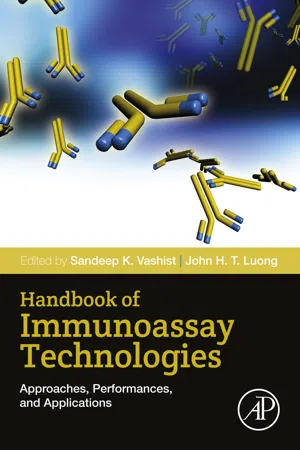
Handbook of Immunoassay Technologies
Approaches, Performances, and Applications
Sandeep K. Vashist,John H.T. Luong
- 496 Seiten
- English
- ePUB (handyfreundlich)
- Über iOS und Android verfügbar
Handbook of Immunoassay Technologies
Approaches, Performances, and Applications
Sandeep K. Vashist,John H.T. Luong
Über dieses Buch
Handbook of Immunoassay Technologies: Approaches, Performances, and Applications unravels the role of immunoassays in the biochemical sciences. During the last four decades, a wide range of immunoassays has been developed, ranging from the conventional enzyme-linked immunosorbent assays, to the smartphone-based point-of-care formats. The advances in rapid biochemical procedures, novel biosensing schemes, fully integrated lab-on-a-chip platforms, prolonged biomolecular storage strategies, device miniaturization and interfacing, and emerging smart system technologies equipped with personalized mobile healthcare tools are paving the way to next-generation immunoassays, and are all discussed in this comprehensive text.
Immunoassays play a prominent role in clinical diagnostics as they are the eyes of healthcare professionals, helping them make informed clinical decisions via confirmed disease diagnosis, and thus enabling favorable health outcomes. The faster and reliable diagnosis of infections will further control their spread to uninfected persons. Similarly, immunoassays play a prominent role in veterinary diagnostics, food analysis, environmental monitoring, defense and security, and other bioanalytical settings. Therefore, they enable the detection of a plethora of analytes, which includes disease biomarkers, pathogens, drug impurities, environmental contaminants, allergens, food adulterants, drugs of abuse and various biomolecules.
- Provides a valuable increase of understanding of cellular and biomedical functions
- Gives the most updated resource in the field of immunoassays, providing the comprehensive details of various types of immunoassays that need to be performed in healthcare, and in industrial, environmental and other biochemical settings
- Discusses all multifarious aspects of immunoassays
- Describes the immunoassay formats, along with their principle of operation, characteristics, pros and cons, and potential biochemical and bioanalytical applications
- Provides extensive knowledge and guided insights as detailed by experienced, renowned experts and key opinion makers in the field of immunoassays
Häufig gestellte Fragen
Information
Immunoassays
An Overview
Abstract
Keywords
1. Overview of Immunoassays
Inhaltsverzeichnis
- Cover image
- Title page
- Table of Contents
- Copyright
- Contributors
- Preface
- Chapter 1. Immunoassays: An Overview
- Chapter 2. Antibody Immobilization and Surface Functionalization Chemistries for Immunodiagnostics
- Chapter 3. Monoclonal Antibody Generation by Phage Display: History, State-of-the-Art, and Future
- Chapter 4. Bioanalytical Requirements and Regulatory Guidelines for Immunoassays
- Chapter 5. Enzyme-Linked Immunoassays
- Chapter 6. Surface Plasmon Resonance–Based Immunoassays: Approaches, Performance, and Applications
- Chapter 7. Lateral Flow Immunoassays
- Chapter 8. Paper-Based Immunoassays
- Chapter 9. Acoustic Wave–Based Immunoassays
- Chapter 10. Interferometry-Based Immunoassays
- Chapter 11. Nanomaterial- and Micromaterial-Based Immunoassays
- Chapter 12. Microcantilever-Based Sensors
- Chapter 13. Quartz Crystal Microbalance–Based Sensors
- Chapter 14. Electrochemical Immunosensors: Fundamentals and Applications in Clinical Diagnostics
- Chapter 15. Lab-on-a-Chip (LOC) Immunoassays
- Chapter 16. Smartphone-Based Immunoassays
- Chapter 17. Immunoassays: Future Prospects and Possibilities
- Index